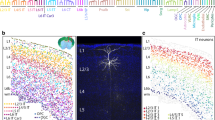Summary
Rat heart slices were incubated with tritium-labeled norepinephrine (NE) or other related amines, exposed to amphetamine or electric field stimulation, and the tritium efflux measured. Pretreatment with reserpine plus the monoamine oxidase inhibitor, pheniprazine, greatly decreased NE efflux following field stimulation, but markedly enhanced amphetamine-induced NE efflux. Pretreatment with 6-hydroxydopamine abolished this effect of amphetamine. Treatment of slices with guanethidine,α-methylnorepinephrine or amantadine also abolished or greatly diminished the amphetamine effect, while phenoxybenzamine or tetrabenazine were without effect. Although amphetamine also released metaraminol, an amine shown to be granule bound even in reserpine-treated systems, amantadine did not, suggesting that amantadine releases amines specifically from an extragranular neuronal binding site. A comparison of release of various amines by field stimulation (a measure of granule amine) and amantadine (a measure of extragranular amine) indicated that the extragranular binding site prefers amines with a catechol group (NE and dopamine) to those without (octopamine, tyramine) and that the beta hydroxyl group is not a significant factor in binding. The extragranular binding site may normally serve as a link in the intraneuronal catecholamine transport system.
Similar content being viewed by others
References
Almgren, O., andP. Lundborg: Release of8H-metaraminol by adrenergic nerve stimulation in reserpine treated rats. Eur. J. Pharmacol.9, 344 to 346 (1970).
Baldessarini, R. J., andI. J. Kopin: Tritiated norepinephrine: Release from brain slices by electrical stimulation. Science152, 1630–1631 (1966).
Carlsson, A., andB. Waldeck: Effects of amphetamine, tyramine, and protriptyline on reserpine-resistant amine-concentrating mechanisms of adrenergic nerves. J. Pharm. Pharmacol.18, 252–253 (1966).
Dengler, H. J., I. A. Michaelson, H. E. Spiegel, andE. Titus: The uptake of labeled norepinephrine by isolated brain and other tissues of the cat. Int. J. Neuropharmacol.1, 23–38 (1962).
Farnebo, L.: Effect of d-amphetamine on spontaneous and stimulation induced release of catecholamines. Acta Physiol. Scand. Suppl.371, 45–52 (1971 a).
Farnebo, L.: Effect of reserpine on release of3H-noradrenaline,3H-dopamine and8H-metaraminol from field stimulated rat iris. Biochem. Pharmacol.20, 2715–2726 (1971 b).
Giachetti, A., andP. A. Shore: Studiesin vitro of amine uptake mechanisms in heart. Biochem. Pharmacol.15, 607–614 (1966).
Iversen, L. L.: The uptake of catecholamines at high perfusion concentrations in the rat isolated heart: a novel catecholamine uptake process. Brit. J. Pharmacol.25, 18–33 (1965).
Lundborg, P., andR. Stitzel: Uptake of biogenic amines by two different mechanisms present in adrenergic granules. Brit. J. Pharmacol.29, 342–349 (1967).
Lundborg, P., andB. Waldeck: On the mechanism of amphetamine induced release of reserpine-resistant3H-noradrenaline and3H-α-methylnor-adrenaline. Acta Pharmacol. et Toxicol.30, 339–347 (1971).
Moore, K. E., L. A. Carr, andJ. A. Dominic: Functional significance of amphetamine release of brain catecholamines. In: Amphetamine and related compounds (Costa, E., andS. Garattini, eds.), pp. 371–384. New York: Raven Press. 1970.
Pletscher, A., A. Brossi, andK. F. Gey: Benzoquinolizine derivatives: A new class of monoamine decreasing drugs with psychotropic action. Int. Rev. Neurobiol.4, 275–306 (1962).
Shore, P. A., andA. Giachetti: Dual actions of guanethidine on amine uptake mechanisms in adrenergic neurons. Biochem. Pharmacol.15, 899–903 (1966).
Stromberg, U., T. H. Svensson, andB. Waldeck: On the mode of action of amantadine. J. Pharm. Pharmacol.22, 959–962 (1970).
Weinshilboum, R., andJ. Axelrod: Serum dopamine-β-hydroxylase: decrease after chemical sympathectomy. Science173, 931–934 (1971).
Ziance, R. J., A. J. Azzaro, andC. O. Rutledge: Characteristics of amphetamine-induced release of norepinephrine from rat cerebral cortexin vitro. J. Pharmacol. Exp. Ther.182, 284–294 (1972).
Ziance, R. J., andC. O. Rutledge: A comparison of the effects of fenfluramine and amphetamine on uptake, release and catabolism of norepinephrine in rat brain. J. Pharmacol. Exp. Ther.180, 118–126 (1972).
Author information
Authors and Affiliations
Additional information
Supported by USPHS Grant MH-05831.
Rights and permissions
About this article
Cite this article
Enna, S.J., Shore, P.A. On the nature of the adrenergic neuron extragranular amine binding site. J. Neural Transmission 35, 125–135 (1974). https://doi.org/10.1007/BF01250740
Received:
Issue Date:
DOI: https://doi.org/10.1007/BF01250740




